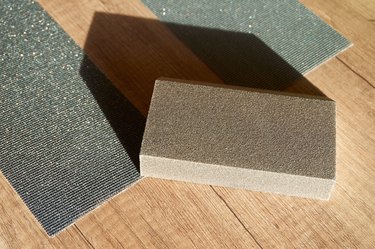
Applying liquid sandpaper is a fast, easy alternative to roughing up a painted surface with traditional sandpaper. Using liquid sandpaper doesn't require special tools or skills. That's what makes it best deglosser for dust-free surface prep. The main benefit is that liquid sandpaper doesn't create wood dust — a common cause of eye, nose, and throat irritation.
How Liquid Sandpaper Works
Video of the Day
Liquid sandpaper quickly dissolves or wears away wood finishes. The product isn't made of paper at all. Instead it's a thick, white liquid full of chemicals like ethyl acetate and naphtha. These ingredients eat away at old paint, varnish, or polyurethane, leaving behind a surface ready for a new coat of finish.
Video of the Day
While liquid sandpaper is an excellent deglosser, it won't smooth uneven surfaces or remove scratches in wood. If your project involves rough or damaged wood, you should use sandpaper or a sanding block instead.
Things You'll Need
Warm, soapy water
Tack cloths or other lint-free cloths
How to Use Liquid Sandpaper
Step 1: Prepare the Surface
Use warm, soapy water to wash the wall or item you want to degloss. You don't need to scrub or use a heavy-duty detergent. Once the area is clean, dry it with a clean cloth or leave it for an hour or two to dry on its own. Excess moisture could affect the liquid sandpaper's effectiveness, so don't skip this step.
Step 2: Apply the Liquid Sandpaper
After putting on protective gloves and goggles, pour a bit of liquid sandpaper onto a lint-free cloth. Rub the liquid sandpaper on the surface using circular motions. Thoroughly cover the surface with a thin even layer of the deglosser.
Step 3: Allow the Liquid Sandpaper to Dry
Let the liquid sandpaper seep into the surface for the time described on the product label. If the product label indicates that you should wipe off or clean the product, do so. However, most liquid sandpaper products do not need to be rinsed — that's what makes this such a great deglosser.
Step 4: Apply a Second Coat of Liquid Sandpaper
Use a clean cloth to apply a second coat of liquid sandpaper. This will ensure that the top coat of paint, varnish, or polyurethane has been thoroughly dissolved.
Step 5: Let the Liquid Sandpaper Dry
Allow the surface to thoroughly dry overnight. Don't worry if a filmy residue remains. If the top layer of finish has been stripped away, you're ready for the next step in your DIY project: applying a fresh coat of paint or stain.
Warning
Wear chemical-resistant gloves and splash goggles when applying liquid sandpaper. Also keep the product away from sparks or open flames because some formulations are highly flammable.